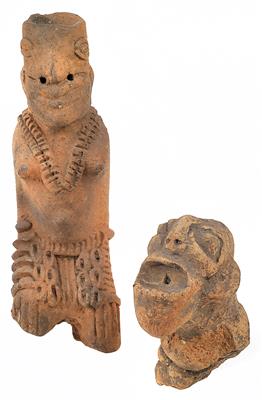Mixed lot (2 items): African archaeology: Ghana: Two so-called 'Komaland figures' made of terracotta,
Mixed lot (2 items): African archaeology: Ghana: Two so-called 'Komaland figures' made of terracotta,

13th-18th century. In the 1980s, the first red-clay figures representing this typical style were discovered by chance in Northern Ghana. They came from large, flat tumuli. In the 1990s, the area in which the Koma Builsa tribe lives today became the object of more careful examination. Sculptures of this type have been called ‘Komaland figures’ since then. Thermoluminescence testing revealed an average age between the 13th and 18th centuries AD:
1: Sitting female figure with a characteristic form: the head displays a cavity with a central hole, which is a frequent feature of ‘Komaland figures’. Both hands rest on her knees. The legs are missing. With ornaments: a necklace, bangles around the right forearm, an apron with cowrie shells. A crack to the back and bottom (glued). H: 22 cm.
2: A head (fragment). The face is turned upwards. The open mouth is crafted in a similar manner to the cavity in the head of the other sculpture of larger size. H: 10 cm. The exact meaning and function of these ‘Komaland figures’ is as yet unknown. (ME)
Provenance: Viennese private collection.
Literature: ‘Discovering the forgotten civilisation of Koma-Land, Northern Ghana’ by L. van Ham & J. Anquandah.
Expert: Prof. Erwin Melchardt
 Prof. Erwin Melchardt
Prof. Erwin Melchardt
+43-1-515 60-465
erwin.melchardt@dorotheum.at
24.03.2014 - 16:00
- Odhadní cena:
-
EUR 1.200,- do EUR 1.800,-
Mixed lot (2 items): African archaeology: Ghana: Two so-called 'Komaland figures' made of terracotta,
13th-18th century. In the 1980s, the first red-clay figures representing this typical style were discovered by chance in Northern Ghana. They came from large, flat tumuli. In the 1990s, the area in which the Koma Builsa tribe lives today became the object of more careful examination. Sculptures of this type have been called ‘Komaland figures’ since then. Thermoluminescence testing revealed an average age between the 13th and 18th centuries AD:
1: Sitting female figure with a characteristic form: the head displays a cavity with a central hole, which is a frequent feature of ‘Komaland figures’. Both hands rest on her knees. The legs are missing. With ornaments: a necklace, bangles around the right forearm, an apron with cowrie shells. A crack to the back and bottom (glued). H: 22 cm.
2: A head (fragment). The face is turned upwards. The open mouth is crafted in a similar manner to the cavity in the head of the other sculpture of larger size. H: 10 cm. The exact meaning and function of these ‘Komaland figures’ is as yet unknown. (ME)
Provenance: Viennese private collection.
Literature: ‘Discovering the forgotten civilisation of Koma-Land, Northern Ghana’ by L. van Ham & J. Anquandah.
Expert: Prof. Erwin Melchardt
 Prof. Erwin Melchardt
Prof. Erwin Melchardt
+43-1-515 60-465
erwin.melchardt@dorotheum.at
|
Horká linka kupujících
Po-Pá: 10.00 - 17.00
kundendienst@dorotheum.at +43 1 515 60 200 |
| Aukce: | Mimoevropské a domorodé um?ní |
| Typ aukce: | Salónní aukce |
| Datum: | 24.03.2014 - 16:00 |
| Místo konání aukce: | Wien | Palais Dorotheum |
| Prohlídka: | 18.03. - 24.03.2014 |
